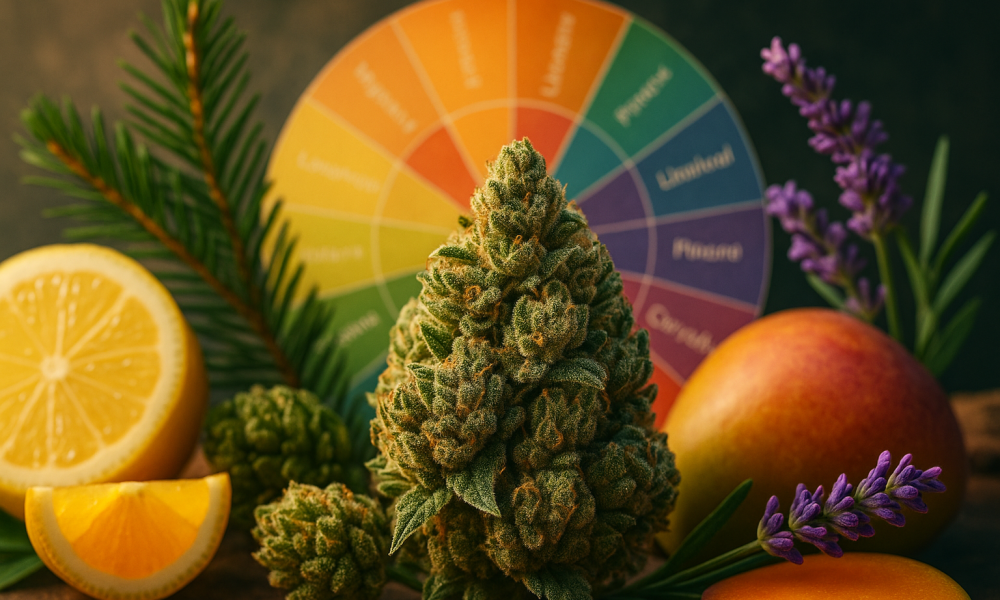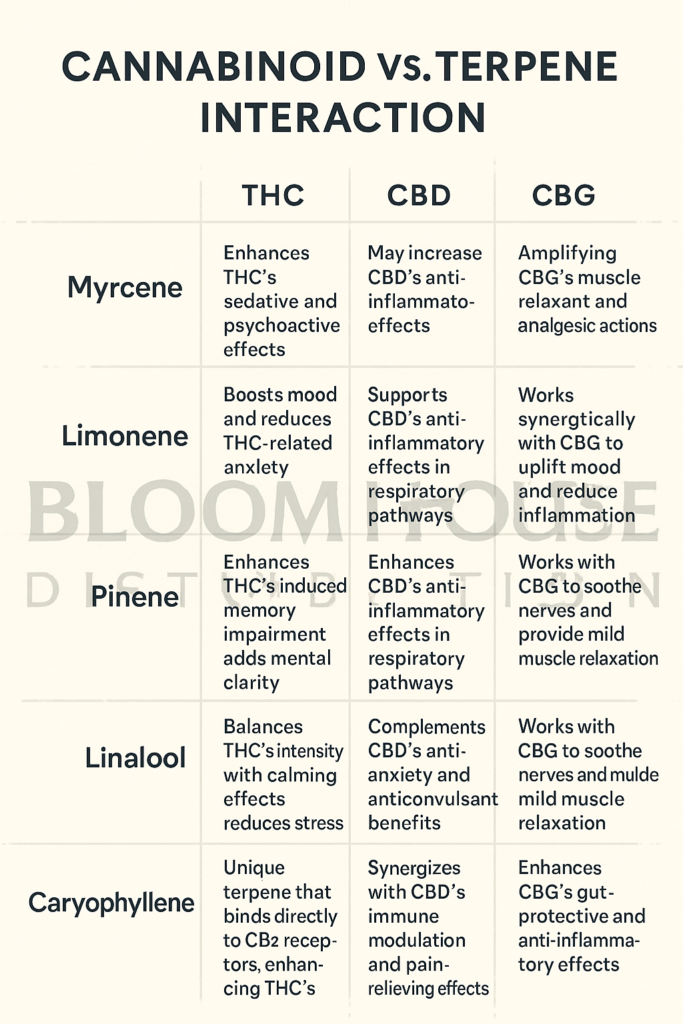“Terpenes 101: The Complete Guide to How Cannabis Aroma Affects Your Body and Mind”

The Hidden Architects of Your High
Picture this: You open a jar of fresh cannabis buds and the aroma hits you—sweet citrus, earthy pine, maybe a spicy hint of cloves. Most of us focus on THC or CBD when choosing a strain, but here’s the twist—those smells are more than just sensory delight. They’re the keys to how cannabis actually makes you feel.
These scent compounds are called terpenes, and they’re not just decorative—they’re active players in the experience. Want to feel sleepy? Look for myrcene. Want to feel energized? Go for pinene or limonene. It’s that simple, and that deep.
In this article, we’ll explore:
- What terpenes are and how they function
- How the Terpene Wheel works (yes, like a flavor wheel but for effects)
- The science behind terpene-THC synergy
- Real-world examples and studies
- Charts, maps, and data for professionals and curious minds
- Tips for growers, buyers, and wholesalers
Let’s dive nose-first into the wonderful world of terpenes.
What Are Terpenes and Why Do They Matter?
Terpenes are aromatic organic compounds found in plants, especially cannabis. They’re responsible for that citrusy smell in lemon, the calming scent of lavender, and yes—how your cannabis strain smells and feels.
But here’s the thing: they do more than smell good.
Scientific research, including a 2020 review in Frontiers in Plant Science, confirms that terpenes interact with the endocannabinoid system (ECS) just like cannabinoids do—enhancing, reducing, or even shaping the psychoactive and therapeutic effects of THC, CBD, and others.
📘 Quick Science:
Terpenes are produced in the trichomes—the sticky resin glands that also make THC and CBD. Think of trichomes as little chemistry labs on the plant.
Example:
Myrcene increases the permeability of cell membranes, potentially allowing more THC to cross the blood-brain barrier. Result? A deeper, more sedating high.
The Terpene Wheel: A Flavor Map of Your High
Let’s introduce your new best friend: The Terpene Wheel.
This circular chart organizes the most common terpenes by aroma, effects, and strain association. Think of it as your “mood map.”
🎡 Terpene Wheel Key Highlights:
| Terpene | Aroma | Effect | Found In Strains Like |
| Myrcene | Earthy, musky | Sedative, sleepy | Granddaddy Purple, Blue Dream |
| Limonene | Citrus | Uplifting, happy | Wedding Cake, Durban Poison |
| Pinene | Pine, fresh | Alertness, memory boost | Jack Herer, Dutch Treat |
| Linalool | Floral, spicy | Calming, anti-anxiety | Lavender, Zkittlez |
| Caryophyllene | Peppery, spicy | Anti-inflammatory, relaxing | Girl Scout Cookies, Bubba Kush |
Fun Fact:
The entourage effect refers to how terpenes and cannabinoids work together, amplifying each other’s effects. Limonene might make a THC-rich strain feel more euphoric, while myrcene can make it more relaxing.
📈 “Cannabinoid vs. Terpene Interaction Matrix”

🔬 Scientific Context
Therapeutic Synergy: Combining specific terpenes and cannabinoids can fine-tune effects like relaxation, focus, anti-inflammation, or euphoria.
Entourage Effect: This refers to the synergistic interaction between cannabinoids and terpenes that enhances the overall therapeutic impact.
Receptor Activity: Terpenes modulate how cannabinoids bind to CB1 and CB2 receptors.
Meet the Terpenes: Your Aroma-Driven Guide to Cannabis Effects
Ever wonder why one cannabis strain makes you melt into the couch while another launches your brain into creative overdrive? The answer isn’t just THC—it’s terpenes, the aromatic compounds that shape not only how cannabis smells and tastes, but also how it makes you feel.
In this section, we’ll take you on a guided tour around the Terpene Wheel, exploring each of the major cannabis terpenes—what they are, how they work, where else they show up in nature, and the fascinating cultural and historical roots behind them. Whether you’re a curious consumer, a seasoned grower, or a wholesaler looking to fine-tune your product line, understanding terpenes will transform how you think about cannabis.
Let’s break them down, one scent at a time. 🌿🧠

🌿 Myrcene: The Sedative Scent of Earth and Comfort
🌿What is Myrcene?
Myrcene (pronounced mur-seen) is the most abundant terpene found in modern commercial cannabis. It gives off an earthy, musky aroma, sometimes likened to cloves or cardamom.
🌿Effects on the Body and Mind:
Myrcene is known for its sedative, muscle-relaxing, and anti-inflammatory properties. In high concentrations, it contributes to the legendary “couch-lock” effect associated with strong indica strains.
🌿Natural Sources Beyond Cannabis:
You’ll also find myrcene in:
- Mangoes (which is why eating mangoes before smoking is rumored to intensify your high)
- Lemongrass
- Hops (used in beer)
- Thyme and bay leaf
🌿Cultural and Historical Insight:
Historically, lemongrass teas rich in myrcene have been used in Brazil and other South American cultures as traditional medicine for sleep and pain. Myrcene also plays a role in Ayurvedic medicine for its balancing and calming energy.
🌿Found In Cannabis Strains Like:
- Granddaddy Purple
- Blue Dream
- Northern Lights
🍋 Limonene: The Citrus Spark of Joy and Energy
🍋 What is Limonene?
Limonene is a bright, citrusy-smelling terpene found not only in cannabis, but in the rinds of lemons, limes, and oranges.
🍋Effects on the Body and Mind:
It’s known for elevating mood, relieving stress, and even acting as an antidepressant. Limonene has been studied for its potential anti-anxiety and anti-cancer effects and is often used in aromatherapy.
🍋Natural Sources Beyond Cannabis:
- Citrus peels (lemon, lime, orange)
- Juniper
- Rosemary
- Mint
🍋Cultural and Historical Insight:
In traditional Chinese medicine and Western herbalism, citrus peels have long been used to uplift the mood and treat digestive issues. Limonene’s clean, sharp scent is even used in cleaning products, not just for smell—but for its antimicrobial properties.
🍋Found In Cannabis Strains Like:
- Wedding Cake
- Durban Poison
- Super Lemon Haze
🌲Pinene: The Forest-Fresh Focus Enhancer
🌲What is Pinene?
Pinene (alpha and beta types) smells exactly like what it sounds like—pine trees. It’s one of the most abundant terpenes found in nature.
🌲Effects on the Body and Mind:
Pinene is a bronchodilator—it opens up the airways, which explains why a walk through a pine forest feels refreshing. It’s known for enhancing focus, memory retention, and alertness. It may also help counteract THC-induced short-term memory loss.
🌲Natural Sources Beyond Cannabis:
- Pine needles and sap
- Basil
- Dill
- Parsley
- Rosemary
🌲Cultural and Historical Insight:
Indigenous cultures have used pine for centuries to cleanse air, enhance lung function, and treat respiratory ailments. In Japanese forest bathing (“Shinrin-yoku”), exposure to pinene-rich forests is linked to improved mental clarity and lower cortisol levels.
🌲Found In Cannabis Strains Like:
- Jack Herer
- Dutch Treat
- Blue Dream
🌸 Linalool: Lavender’s Calming Companion
🌸What is Linalool?
Linalool has a soft floral, spicy scent, most famously found in lavender. It gives strains a calming undertone that balances out high-THC psychoactivity.
🌸Effects on the Body and Mind:
Linalool is prized for its anti-anxiety, anti-depressant, and sedative effects. Studies also point to its anti-inflammatory and anti-convulsant properties. It’s often included in sleep aids and essential oil blends.
🌸Natural Sources Beyond Cannabis:
- Lavender
- Coriander seed
- Rosewood
- Birch bark
🌸Cultural and Historical Insight:
Linalool has been used for centuries in European and Middle Eastern herbal traditions. Lavender oil—rich in linalool—is used in Ayurveda and Persian medicine to promote sleep and emotional balance.
🌸Found In Cannabis Strains Like:
- Amnesia Haze
- Zkittlez
- Do-Si-Dos
🔥 Caryophyllene: The Spicy Protector of Your Body
🔥What is Caryophyllene?
Beta-caryophyllene (BCP) is a unique terpene with a peppery, spicy aroma. What makes it special? It also acts like a cannabinoid, binding directly to CB2 receptors in the body.
🔥Effects on the Body and Mind:
Caryophyllene is deeply anti-inflammatory, making it a favorite in pain relief and arthritis formulas. It offers stress-relief without causing a high, making it suitable for medical cannabis products.
🔥Natural Sources Beyond Cannabis:
- Black pepper
- Cloves
- Cinnamon
- Hops
- Oregano
🔥Cultural and Historical Insight:
Traditional medicine in Africa and Asia has long used black pepper and clove oils to fight infection, inflammation, and even toothaches. Modern research supports its role as a gut protector.
🔥Found In Cannabis Strains Like:
- Girl Scout Cookies
- Bubba Kush
- Chemdawg
🌿 Ocimene: The Herbal Energizer
🌿What is Ocimene?
Ocimene is a lesser-known terpene with a sweet, herbaceous aroma, sometimes with citrus or woody notes. It’s known for its uplifting and social effects.
🌿Effects on the Body and Mind:
It may offer anti-viral, anti-fungal, and anti-inflammatory effects, and is often linked to energized, talkative, creative experiences.
🌿Natural Sources Beyond Cannabis:
- Basil 🌿
- Mint
- Mango
- Orchids
🌿Cultural and Historical Insight:
Used in traditional perfumes in the Middle East, Ocimene carries a light, “green” signature that represents openness, clarity, and transition. It also repels pests—earning its nickname as the plant’s “natural bodyguard.”
🌿Found In Cannabis Strains Like:
- Strawberry Cough
- Sour Diesel
- Golden Goat
🍉 Terpinolene: The Fruit-Floral Mystery
🍉What is Terpinolene?
Terpinolene has a complex aroma—a mix of fruity, floral, and piney. It’s not dominant in most strains, but when it is, it stands out.
🍉Effects on the Body and Mind:
It’s often uplifting, yet slightly sedative—a bit of a paradox. Terpinolene also has antioxidant, antibacterial, and antifungal properties.
🍉Natural Sources Beyond Cannabis:
- Apples
- Cumin
- Lilac
- Tea tree
🍉Cultural and Historical Insight:
In folklore and traditional Eastern European practices, lilacs (rich in terpinolene) are associated with cleansing and transitions—fitting, considering terpinolene’s light psychoactivity and emotional “reset” effect.
🍉Found In Cannabis Strains Like:
- Ghost Train Haze
- XJ-13
- Jack Herer
🌳 Humulene: The Appetite Suppressant in Disguise
🌳What is Humulene?
Humulene smells earthy and woody—like hops. It was originally known as alpha-caryophyllene, but has since been identified as its own terpene.
🌳Effects on the Body and Mind:
Humulene may act as an appetite suppressant—the opposite of the “munchies.” It’s also anti-bacterial and anti-inflammatory, often working synergistically with caryophyllene.
🌳Natural Sources Beyond Cannabis:
- Hops
- Coriander
- Ginseng
- Sage
🌳Cultural and Historical Insight:
Hops, long used in beer and medicine, are central to European and Chinese traditional medicine. Ginseng-humulene combinations are used to balance body energy, suppress appetite, and boost immunity.
🌳Found In Cannabis Strains Like:
- Headband
- White Widow
- Girl Scout Cookies
Science Behind Terpene Effects: Studies and Synergy
There’s growing peer-reviewed research confirming terpene-specific effects.
🔬 Example Studies:
- A 2021 study in Nature’s Scientific Reports confirmed that myrcene exhibits muscle-relaxant and sedative effects in rodents—supporting its “sleepy” reputation.
- A 2020 paper in Frontiers in Neuroscience showed limonene enhances dopamine levels, supporting its uplifting and antidepressant-like effects.
📘 Pro Tip for Professionals:
Pairing limonene-rich strains with THC-dominant extracts can create highly marketable, “happy high” products for daytime use.
Real-World Application: How to Use Terpenes to Choose Your Experience
🎯 For Beginners:
- Feeling anxious? Try linalool or myrcene-heavy strains like Zkittlez.
- Need focus and clarity? Go with pinene-rich options like Jack Herer.
🌱 For Growers:
- Terpene content can be increased through soil quality, stress techniques, and lighting.
- Living soil tends to produce richer terpene profiles vs. hydroponics.
🧪 For Wholesalers:
- Market strains not just by THC %, but by dominant terpene and effect type.
- Example: “Sleep Formula: Granddaddy Purple (Myrcene-dominant) – Relaxation in 15 minutes.”
Case Studies: How Companies Use Terpenes to Brand Cannabis
🌿 Case 1: “Calm Line” by Flow Kana
Flow Kana’s branding revolves around terpene effects—each line (Calm, Uplift, Focus) is terpene-selected. Their Calm line highlights myrcene and linalool—marketed as “wine-down” weed.
🚀 Case 2: “Daytime THC” by Cresco Labs
Cresco blends limonene and pinene in sativa-dominant oils—emphasizing productivity, alertness, and mood.
Practical Tips to Boost Terpene Experience
- Store your cannabis right: Keep buds in glass jars, cool, dark places. UV light and heat degrade terpenes.
- Don’t overheat when vaping: Use a low-temp vaporizer to preserve delicate terpenes.
- Look for full-spectrum extracts: These retain the natural terpene profile, unlike distillates.
How to Choose the Right Terpene Profile For You
Here’s a simple method anyone can use:
🛠️ Step-by-Step “Effect First” Approach
- Choose the desired effect (sleep, euphoria, pain relief).
- Match it to the terpene using the Terpene Wheel.
- Cross-check strains rich in that terpene.
- Read lab results or COAs.
- Try microdosing first to dial in results.
10 Must-Know Terms in Cannabis Terpene Science
| Term | Definition |
| Terpene | Aromatic compound affecting scent and effect |
| Entourage Effect | Synergy between terpenes and cannabinoids |
| Myrcene | Sedative terpene found in earthy strains |
| Limonene | Uplifting terpene with citrus aroma |
| COA (Certificate of Analysis) | Lab test showing terpene/cannabinoid content |
| Chemovar | Chemical variety of cannabis (strain by composition) |
| Full-Spectrum | Cannabis extract retaining all natural terpenes |
| Trichome | Resin gland where terpenes are produced |
| Linalool | Calming terpene with floral scent |
| Beta-Caryophyllene | Spicy terpene that interacts with CB2 receptors |
Smell Your Way to the Perfect High
Terpenes are more than just aromatic sidekicks—they are co-directors of your high. The citrus burst of limonene, the piney clarity of pinene, the dreamy depth of myrcene… together, they shape the journey from your nose to your brain.
Whether you’re a casual user or a cannabis professional, understanding terpenes means making smarter, more tailored choices. It’s the future of personalized cannabis.
✅For Buyers & Wholesalers
Looking for strains rich in specific terpenes? Head over to our Shop Page and browse curated products from top-tier, lab-tested producers—categorized by effect, aroma, and terpene profile. Personalize your high, boost your sales, and stock what your customers actually need.
Which terpene do you swear by—Myrcene, Limonene, or something more exotic like Ocimene?
Drop your favorite strain and how it makes you feel in the comments—we’d love to hear your terpene tales!
